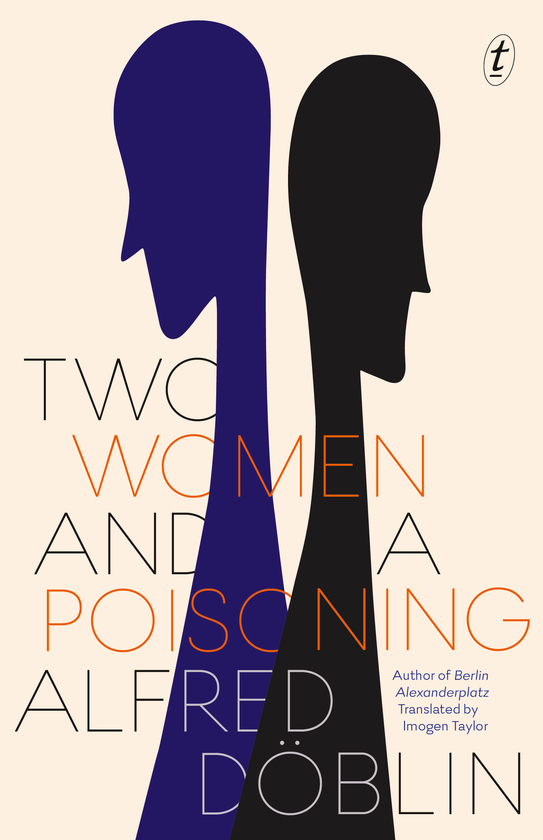TWO WOMEN AND A POISONING
Alfred Doeblin
Text Publishing
REVIEWED BY JESSIE NEILSON
Alfred Doeblin (1878-1957), a German Jew, doctor and psychiatrist, was also a prolific and varied writer and a major figure in German literary modernism.
While his contemporaries such as Bertolt Brecht and Thomas Mann are hugely regarded, Doeblin is lesser known, though his entire output, including novels, essays, radio plays, and philosophical treatises, is thought to reach more than 30 volumes. His most famous work is the novel Berlin Alexanderplatz.

The 1924 novella, Die beiden Freundinnen und ihr Giftmord, here translated, was the first of an aborted series of short classics based on crimes of the day. This story reimagines the Klein-Nebbe case, which led to a sensational trial in Berlin in 1923. The main players are working-class Berliners, familiar subjects to Doeblin. Here he lays forth a version of the death of a man by arsenic and the failed attempt at killing another. The perpetrators were their wives, lovers Ella Klein and Margarete Nebbe, who wanted rid of their controlling, and in Ella's case, sadistic and brutal, spouses.
This is a very strange little book. Doeblin's writing is characterised by the absence of any unnecessary flourishes, stripped to bare-bone, straightforward sentences, neatly finished. As translator Imogen Taylor describes in her introduction to this English language edition, the author is completely self-effaced. Doeblin refers to himself as being like a streetlamp, ‘‘stone style’’, observing the action and lighting it up a little.
Another feature which sets it in the German modernist/expressionist tradition is the almost contradictory liveliness of the characters themselves, the two women with their flailing and theatrics like the dramatic personnel of a 1920s expressionist film. One moment the women are declaring their love for each other and running into each other's arms, and the next they are locked in violent, passionate embraces with their husbands, before this rapidly changes to murderous intentions and then again back to amour.
This is an imaginative, speculative reproduction of the true event. Ella, called Elli here, and Grete rage through the days and nights of the early 1920s, plotting, planning, loving and inciting. They seem clueless as to what they desire from each other, from their husbands, or from their lives. Elli's husband, in the end to meet his death by poisoning, stands out as a pure villain. We are informed that ‘‘Elli, who had skipped into marriage with a smile and a sneer, had met with a brutal master’’. Recurrent words and images include sadism, brutality, violence, passion, intoxication and ‘‘boundless, tumultuous hatred’’. Carpenter Link plagues Elli like an insect, demanding sex and attacking her with truncheons, whereas she, repulsed by the physical as she is drawn to it, is pretty and blonde, light-hearted and vivacious, and ‘‘blithe as a canary’’.
Two Women cannot help but conjure up the German folklore tradition, of the play of dark and light, good and evil and their intermingling. Elli and Grete are like Hansel and Gretel, escaping a menacing place that contains all wicked things, while also running towards it. Symbolism is explicit, where in Elli's delirious, interrogative nightmares following her incarceration the now plain-looking creature, with her ‘‘birdlike’’ head, is locked in a room with endless dead people that she is washing and dressing.
With his unusual authorial hand, Doeblin encourages his reader to watch his characters and make sense of and react to them. Though he is a psychiatrist he does not interpret the material for the reader, but rather presents it bluntly. He is intrigued by motivation and what would drive characters in their interactions and decisions. When he moves through to the trial of March 1923, he lays out the possible combinations of verdicts. When his text ends, graphs take up. Pages of Venn diagrams map the changing phases of the main characters' personalities, in the clinical psychiatric arena.
Two short pieces by Joseph Roth and Robert Musil, fellow writers of the time, finish the book, offering their creative interpretations of the trial. The reader comes away from the work with a myriad of impressions and interpretations: have we been subjected to farce, or the subject of it? To what have we been witness, thrown in as we have been amongst these emotional, sordid, puppet-like creatures? For the reader it is as frightening as it is perplexing, as Doeblin has leapt off a true event into an all-involving piece of art.
Jessie Neilson is a University of Otago library assistant












